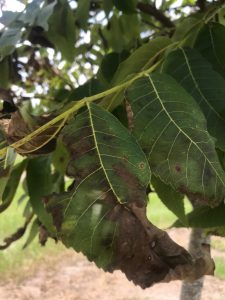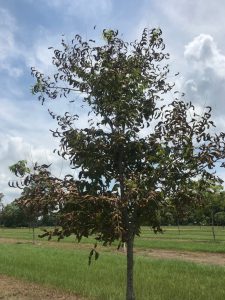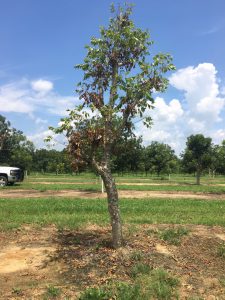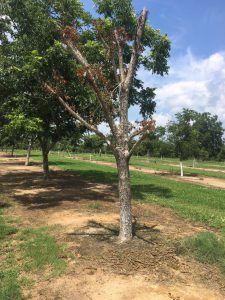Over the last week I have had at least 5 separate calls from different parts of the state regarding trees–usually in the range of 2 years old up to 12-15 years old– exhibiting die back of branches/central leader and leaf burning or scorching. In many cases it is more severe than the normal leaf scorching we see on young trees and some of the trees have actually died. Symptoms begin as a few shoots dying back and it progresses rapidly from there.
Anytime you get leaf scorching and die-back like this, there is some damage to the root or vascular system. During a hurricane/tropical storm or severe winds trees take quite a beating and are whipped around for an extended period of time. Young trees, particularly if they are pruned to a central leader, may remain upright and survive the storm because they don’t have a large canopy to catch the wind. Yet they still get beaten back and forth. The violence of the wind, though it doesn’t blow the tree down, often still breaks roots below ground.
There is often enough root remaining to allow the tree to survive and begin growth the following year but when the new growth reaches a certain point and the water demand increases to supply that new growth in the heat of summer, the tree has not been able to develop enough new roots to sustain that growth and it goes into shock and begins to die-back. If the root to shoot ratio is small enough the tree may die completely.
We have been expecting to see this based on what we know from previous hurricanes in other areas. Given the widespread hurricane damage with Michael and the widespread occurrence of this problem, I attribute this to delayed hurricane damage. The only thing you can really do for this is cut the tree back to improve the root to shoot ratio and keep it well watered. The more severe the die-back is when observed, the more you need to cut the tree back. The worst trees may need to be cut back by half if the cambium is still green under the bark.
In some cases older trees that had been righted after the storm are showing the same symptoms. In this case, when the trees were stood up again, roots were broken on the opposite side of the tree. Again, the tree likely had enough root to survive initially and begin re-growth this year but crashed when the heat and water demand ramped up too much.
Spaded trees in this situation could be cut back some more but they have already been cut back prior to righting so there’s often not a lot left to cut. Had the tree on the right been cut back a little more (similar to the one on the left), it likely would have survived.





